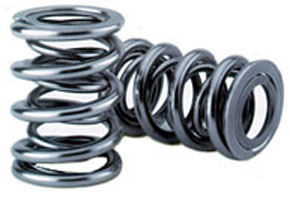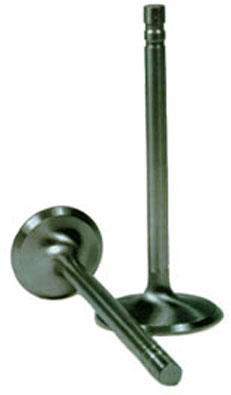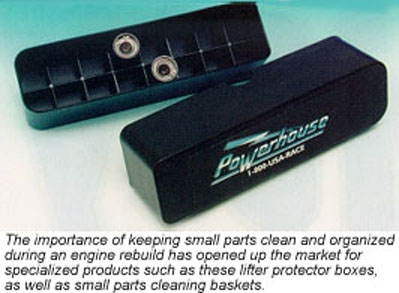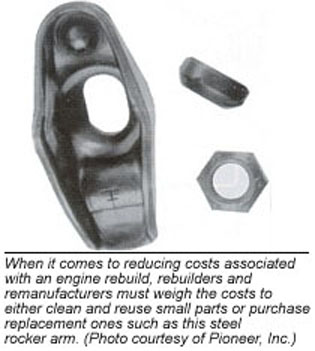
Tom Nichols, CEO and president of Automotive
Machine & Supply, Inc., Fort Worth, TX, said availability
is most often the key to why his shop cleans and reuses small
parts. Nichols said each day his shop cleans and reuses many small
parts, including valve locks, shims, springs, retainers, rocker
arm assemblies, cam bore caps, nuts, bolts, etc. "Because
we only rebuild import engines, many times we must reuse parts
that are just not available," he said.
However, not all small parts are cleaned for an engine rebuild.
Nichols said there are some small engine parts that Automotive
Machine & Supply will replace with new during an engine rebuild,
such as exhaust valves, timing chains, tensioners, lock tabs and
some head bolts.
Bruce Chapman, president of Ontario Reman, a PER in Etobicoke,
Ontario, Canada, said his facility, which remans about 10 engines
a day, also installs some new small parts while cleaning others.
"It all depends on the wear factor," Chapman said. "But
because every block from Ontario Reman is rebored and comes with
new oversized pistons, piston cleaning is eliminated and the pistons
are scrapped."

Lifters at Ontario Reman are either cleaned or installed new.
Those that pass a preliminary inspection are contracted out for
cleaning. "It also depends on the price, whether it’s more
economical to reuse or to buy new," said Chapman. "You
have to factor in time and labor. For certain engine blocks, it
may be necessary to have the lifters cleaned due to a shortage
of available replacements."
Jonathan Smith, president of Motor Replacement Co., Inc., Phoenix,
AZ, said his company’s Roadrunner Engines are remanufactured with
all new small parts, which result in a higher cost for the finished
product. "Most engine remanufacturers use reground valves,
refaced rockers, used valve springs and used pushrods," Smith
said. "We use only new parts in our heads which assures a
long and dependable service period. Of course this means our pricing
in some cases is higher."
Ontario Reman’s Chapman said the type of engine also will dictate
differences in cleaning times and requirements. "Whereas
the Chrysler 318 has very few small parts, Chrysler’s 3.0L overhead
cam engines contain many more, so you’ll have more money and time
wrapped up cleaning these engines," he said.
Chapman said cleaned small parts can provide a better method to
inspect components for reuse. "Only after parts are thoroughly
and properly cleaned can an effective inspection be made,"
he said. "Therefore, all contaminants such as grease, oil,
scale, grime and rust must be removed."
Chapman said Ontario Reman has one teardown employee who handles
the cleaning process. And because Ontario Reman only remanufactures
Chrysler engines, cleaning processes can be simplified. Most often,
all small parts (of the same material) are just combined and cleaned
together. After cleaning, the parts are sorted and inspected.

"Sure you may clean some garbage and unusable parts, but
it’s far better to thoroughly inspect parts after they’re cleaned
than to spend a lot of time trying to inspect them when they’re
dirty," said Chapman. "Even if you inspected the parts
prior to cleaning, you would still have to inspect them again
after they were cleaned."
Nichols said Automotive Machine & Supply, which rebuilds about
200 heads and 20 engines each month, views cleaning and inspection
as the number one step to performing quality work – not as a necessary
evil. Nichols said his shop also combines small parts of the same
material when cleaning.
"Most of these small engine parts are put in a gallon paint
bucket with 1/8" holes drilled all over it and left to soak
in either a hot caustic vat (for steel components) or a hot detergent
vat (for aluminum parts)," Nichols said. "Other items
such as hydraulic lash compensators are washed by hand using spray
carb cleaner. Other parts may be vatted, then wire buffed by hand
or bead blasted. We do very little hand washing or hand scrubbing
in a parts washer because it is not cost or time efficient."
Nichols said cleaning times vary by the component. "Any hand
cleaning of small parts will take the longest amount of time,
such as hydraulic lifters," he said. "But anything we
can just drop in the vat and let soak is least time consuming."
Ontario Reman’s Chapman said to save time at his facility, most
small parts are batch cleaned where a couple hundred similar pieces
are loaded into a tank where they soak overnight. "Although
the parts don’t need to clean for that length of time, overnight
cleaning is an efficient process for a PER like us," Chapman
said.
R. Anthony Harper, manager of J & H
Diesel Service, Inc., Greenville, MS, a diesel fuel injection
rebuilding facility, said no matter what component is being cleaned,
an improper cleaning method can be more harmful than not cleaning
at all. "It’s important to know your product," Harper
said. "For example, when cleaning a diesel fuel injector,
the nozzle tips are NEVER buffed," he said.
Harper said J & H, a 23,000-sq. ft. facility
with 20 employees that specializes in diesel fuel injection and
turbocharger systems for farm applications, industrial equipment,
automotive, marine (including EMD), and heavy duty diesel engines,
rebuilds hundreds of diesel fuel injectors each month. Harper
said processes used to clean specialty components, such as fuel
injectors, are similar to small engine components. "We disassemble
all the injectors, soak the parts in an aqueous parts cleaner,
wash them out with mineral spirits and polish the nozzle tip with
an industrial cleaner that cuts carbon and cleans to a shine,"
he explained. "After that, the injector body is buffed."
Automotive Machine & Supply’s Nichols said parts cleaning
equipment manufacturers have also improved machinery to make the
cleaning of small parts easier. "Today’s ovens have better
features and oil skimmers, filters and pumps have improved sludge
containment," he explained. "Even spray nozzle designs
and basket drives for jet washers have been greatly improved for
cleaning efficiency."
Some shops are also experimenting with nontraditional cleaning
methods in an effort to improve the process. Marty Ehman, president
of Global Sonics, Bountiful, UT, which manufactures The Grease
Monkey ultrasonic parts cleaner, sees ultrasonic cleaning as a
logical step toward improved parts cleaning technology. "Ultrasonic
cleaning is based on a phenomenon called cavitation," Ehman
said. "This occurs when high-frequency, high-intensity sound
waves are introduced into a liquid producing countless micro-bubbles
or cavities in the solution."
Ehman said these micro-bubbles rapidly form and then violently
collapse or implode when they come in contact with the surface
to be cleaned. "It is estimated that pressures as high as
10,000 psi are produced in the immediate area of each implosion,"
Ehman said. "These countless implosions produce a universally
dispersed and highly effective scrubbing on all exposed and hidden
surfaces of the parts removing carbon, varnish, rust, grit and
grime from every surface, nook and cranny."
It’s easy to understand why cleaning equipment manufacturers are
looking at ways to improve their machines. Nichols, an ASE Master
Machinist, said cleaning was the most expensive, time consuming
and critical step in engine rebuilding in 1964, when his shop
opened for business, and it is still true today. "How parts
are cleaned and inspected determines whether or not a machine
shop will make a profit or go under," Nichols said. "Yet
many shops pay the least wages to and give little or no training
to employees who do the dirty work of cleaning.
In our shop cleaning employees must complete a training course
on proper cleaning and inspection methods. Then, depending on
their score, they receive a pay raise and are put in charge of
scheduling all work going through the shop…making sure each
machinist receives the correct, clean parts for each item at the
proper time."

But Nichols added that while cleaning small parts can save a shop
money by not having to purchase new replacement components, cleaning
comes at a cost. "Many times we must clean items at no charge
just to ensure that it won’t compromise the other machine work
we do," he said. "For example, it may take 30 minutes
to properly clean a timing cover on a chain-driven DOHC Nissan
– a value of $35. But getting a customer to pay for that is almost
impossible. Most customers, even professional mechanics, don’t
value cleaning very highly. But not cleaning the cover may jeopardize
the $2,000 long block we just rebuilt."
Doug Anderson, vice president of Grooms Engines, Parts, Machining,
Inc., Nashville, TN, said rebuilders are constantly looking for
ways to reduce the costs associated with cleaning small parts.
"For years we had a solvent sink in the assembly area for
detailing small parts, but it became too expensive to operate,
so we tried something different."
Anderson said because the unit was inside the shop, Grooms also
had to retain a VOC permit because of the evaporation of "volatile
organic compounds" from the solvent. "In order to maintain
the permit, we had to measure the amount of solvent that came
and went so we could determine how much had evaporated,"
he said.
Anderson said the shop also was required to keep the lid closed
when the sink wasn’t in use, as well as keep a log of the hours
that it was used. Once a year, a report had to be submitted and
a permit fee paid to the city. A few years ago, Grooms purchased
a sink from Grainger, Chicago, IL, a nationwide supplier of industrial
and shop tools and equipment, and connected it to a 35-gallon
drum that has an electric immersion heater installed in it. Using
a water-based cleaner at about 12% solution heated to 130°
F, the sink is located near one of the shop’s jet spray washers.
The location makes it easy to pump the solution into the holding
tank when it needs to be changed. "By eliminating the solvent,
we have been saving more than $8,000 a year, " Anderson said.
"And we were finally able to eliminate the need for a VOC
permit."
Rebuilders also need to keep in mind that when it comes to cleaning
aluminum parts, the cleaning processes are often very different
than those associated with cleaning steel/cast iron parts. Kansas
Instruments’ Dave Cox said although aluminum parts will have many
of the same carbon deposits and oil sludge on them as their cast
iron counterparts, special care must be used to clean them. "Small
aluminum parts cannot be baked at high temperatures nor cleaned
with harsh chemicals," Cox warned.
Automotive Machine & Supply’s Nichols said his shop has specialized
in aluminum and magnesium engines and small parts for 34 years.
"We have experimented with many different processes trying
to find the best for quality, the environment and profits,"
Nichols said. "We think we have found the best for our shop
– but we are continually looking for better ways to clean parts.
We’ve even tried blasting with baking soda and dry ice,"
he added.
Another change in small parts cleaning is the types of solvents
available. Because of environmental concerns, Nichols said "old-fashioned
carburetor cleaner" is no longer used in the cleaning process.
"The old soaking kind of carburetor cleaner is too harmful
for the environment," said Nichols. "We use non-chlorinated,
consumer-grade spray cans. This is cheaper than other products
and satisfies the hazardous waste and workplace laws.
Today, more and more parts cleaner manufacturers are creating
water-based or bio-degradable cleaners and degreasers that meet
Occupational Safety and Health Administration (OSHA) and Environmental
Protection Agency (EPA) standards.
One such aqueous, non-volatile parts cleaner/degreaser manufacturer
is Mirachem Corp., Tempe, AZ, which makes a spray can parts cleaner.
Founded by Jim Edwards, a former auto racer who sought a solution
to solvent sensitivity as he restored cars, Mirachem addresses
today’s environmental issues which weren’t major concerns for
parts cleaning products in the past. "When I first formulated
this non-caustic, non-corrosive product 20 years ago, no one cared
about the environment," Edwards explained. "I was just
looking for a way to stop the skin from falling off my own hands.
"Now no company that operates in a global business climate
can afford to ignore air quality issues. Workers demand safe solvents,
so it helps that these products also work as well as the previous
hazardous solvents."
Andy Hernandez, who manufacturers the Green World environmental
parts washer, said today’s biodegradable soaps, along with heated
water, can clean just as effectively as caustic solutions. Hernandez
said although separate soaps are available to clean only aluminum
or only steel/cast iron, many shops blend the soaps to save cleaning
time. "Biodegradable soaps are blended to clean aluminum,
cast iron, steel, plastic and rubber without damage," he
said, adding the soaps also contain an anti-rust additive to protect
parts from corrosion.
Following other cleaning processes, sometimes parts are given
a coating to protect them against rust while in storage. Kansas
Instruments’ Cox said parts that will be in long term storage
will look better with some type of coating protection, adding,
however, that many rust inhibitors used in rinse cycles of today’s
cleaning equipment do eliminate the need for a protectant.
Nichols said after most small parts are aqueously cleaned at Automotive
Machine & Supply, they are dried in a bake oven followed by
a shot of WD40®.
Just as some small engine components are treated following the
cleaning process, J & H Diesel Service’s Harper said his shop
will cold blue the nozzles of some fuel injector models to prohibit
rusting while in the engine. "Some injectors are also painted
before they are returned to the customer," he said.
The issues of sorting and storing small parts can also be an obstacle
for remanufacturers. Dana Pickup, president of Cuba Specialty
Mfg., Inc., Fillmore, NY, a manufacturer of automotive parts baskets,
said there is growing interest by rebuilders for an inexpensive
and organized method to sort, clean and store their small parts
for cleaning. "There’s a lot of rebuilders out there using
various sized paint cans or coffee cans that are drilled with
holes in order to clean and store parts," Pickup said. "But
there really isn’t much in the way of an inexpensive, convenient
parts basket system available to the industry."
To accommodate that need, Pickup said Cuba has added two sizes
of Small Parts Keepers to its popular Gee-Z line of parts baskets.
"These Parts Keepers are specially designed to hold and organize
the small parts associated with carburetor, engine, electrical
and transmission rebuilding," Pickup said.
Pickup explained his Gee-Z line of parts baskets were introduced
at the Engine Rebuilders Association (AERA) show in April of 1997.
When talking to rebuilders, Pickup learned many shops were searching
for a smaller version of his economical baskets that could hold
small engine parts. Pickup then designed a smaller-mesh basket,
calling it a Small Parts Keeper. "We took prototypes to the
Automotive Parts Rebuilders Association Show (APRA) in October
or ’97 and were met with tremendous response," Pickup explained.
"We sold thousands of the baskets at the show, mostly to
electrical rebuilders. When we returned from the show, we went
right into production."
Cuba said the Parts Keepers are made of size 8 mesh (1/8"-holes)
galvanized wire and can be used in aqueous spray washers, spray
booths or tanks to soak small parts. Pickup recommends using the
baskets in non-caustic solutions. "We are experimenting with
a stainless steel wire design because the galvanized coating will
wear off in a caustic solution," explained Pickup. "The
stainless steel wire will be more expensive, but we’re continually
looking at ways to accommodate the rebuilder’s cleaning needs."
The following are some component parts cleaning tips provided
by rebuilders and parts equipment manufacturers interviewed for
this article. Other forms of cleaning may be just as viable depending
on the quantity, materials and equipment employed.
- Pistons – Disassemble and remove rings.
The piston may be initially cleaned in an aluminum-safe spray
washer or soak tank. The second process will be to glass bead
the piston top only.
Piston cleaning is usually not done as labor
costs are usually too high and potential part failure rates too
high. Blocks usually have wear areas and require reboring anyway.
Nichols said pistons are usually replaced new in his engines,
although those that are reused are soaked in a hot detergent vat,
rinsed with water and the tops carefully and gently wire wheel
buffed.
- Intake valves – soaked in hot caustic and
wire wheel buffed; stems are polished with a 600-grit belt and
inspected for burrs, etc. Valves also can be cleaned in a media
tumbler with a solvent where stem protectors are used on the valve
ends. Valves can then be glass beaded for cosmetics.
- Non-hydraulic lifters – hot caustic soak.
- Hydraulic lifters are hand washed with
spray carb cleaner. - Steel rocker springs – soaked in a hot
caustic vat. - Crankshafts can be soaked in hot caustic
vat, later they can be wire wheel buffed or bead blasted. Heat
cleaning is another option. - Camshafts can be cleaned the same as cranks
with the exception of the bead blasting process. - Rockers – may be cleaned in steel media
tumbler for 10-15 minutes or may be cleaned in a spray washer
or soak tank. (Many shops recommend that aluminum rockers should
be soaked in a non-caustic hot detergent vat). - Valve springs – cleaned in a media tumbler
with solvent or spray wash or soak tank.













